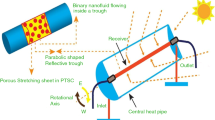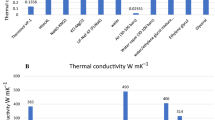Abstract
Boiling heat transfer coefficient is one of the most efficient factors on the amount of transferred heat by boiling flow. New nanofluids have been extensively utilized for enhancing the performance of boiling process. Despite many experimental investigations around the pool boiling heat transfer coefficient of nanofluid, the precise mathematical scheme for the evaluation of this factor is of scarce up to now. The purpose of this research is prediction of heat transfer coefficient of Al2O3–water nanofluids in a nucleate pool boiling at low heat fluxes. The apparatus has been built to study the heat transfer coefficient in a nucleate pool boiling. Al2O3 nanoparticles are scattered into the pure water, and stability treatments are performed for the nanofluids. In the numerical simulation, the Eulerian two-phase method is applied and empirical correlations are utilized to predict bubble parameters. Since the concentration of nanoparticles in the nanofluid is low, it is considered as a homogenous liquid. Finally, a predictive equation is proposed for the heat transfer coefficient of nanofluid by using the response surface methodology. The investigated variables have a distance from the center of boiling surface, applied heat flux, nucleation site density, frequency of bubble, and bubble departure diameter. Statistical parameters reveal that the accuracy of model is suitable. Also results of response surface method demonstrate that nucleation site density and bubble departure diameter have the most and least effect on the heat transfer coefficient, respectively.












Similar content being viewed by others
Abbreviations
- A c :
-
Natural convection surface (m2)
- A q :
-
Quenching surface (m2)
- ANOVA:
-
Analysis a variance
- C D :
-
Drag coefficient
- C p :
-
Heat capacity (kJ kg−1 k−1)
- d bw :
-
Bubble departure diameter (mm)
- DI:
-
Deionized
- E :
-
Total energy of phase (j)
- F :
-
Body force (N)
- F :
-
Bubble departure frequency (1/s)
- h fg :
-
Latent heat (kJ kg−1)
- HPF:
-
Heat flux partitioning
- I :
-
Electric current (Amp)
- N a :
-
Active nucleation site density (1/m2)
- P :
-
Pressure (Pa)
- Pr :
-
Prantle number
- q :
-
Applied heat flux (kW m−2)
- q c :
-
Natural convection heat flux (kW m−2)
- q e :
-
Evaporation heat flux (kW m−2)
- q q :
-
Quenching heat flux (kW m−2)
- r :
-
Radius of heater (mm)
- Re :
-
Reynolds number
- T :
-
Temperature (K)
- T b :
-
Bulk temperature of liquid (K)
- T w :
-
Temperature of boiling surface (K)
- t :
-
Time (ms)
- t g :
-
Bubble growth time (ms)
- t w :
-
Bubble waiting time (ms)
- V :
-
Voltage (V)
- bf:
-
Base fluids
- l:
-
Liquid
- nf:
-
Nanofluids
- np:
-
Nanoparticles
- s:
-
Solid
- sat:
-
Saturated
- Γkj :
-
Interfacial mass transfer (kg m−3 s−1)
- α :
-
Volume fraction of phases
- θ :
-
Liquid contact angle (°)
- λ :
-
Thermal conductivity (kW m−1 k−1)
- µ :
-
Dynamic viscosity (kg m−1 s−1)
- ρ :
-
Density (kg m−3)
- σ :
-
Surface tension (N m−1)
- φ :
-
Volume fraction of nanoparticles
References
Choi S. Enhancement thermal conductivity of fluids with nanoparticles. ASME Fluid Eng Div. 1995;231:99–105.
Ahmadi MH, Nazari MA, Ghasempour R, Madah H, Shafii MB, Ahmadi MA. Thermal conductivity ratio prediction of Al2O3/water nanofluid by applying connectionist methods. Colloids Surf A. 2018;541:154–64.
Ahmadi MH, Hajizadeh F, Rahimzadeh M, Shafii MB, Chamkha AJ, Lorenzini G, Ghasempour R. Application GMDH artificial neural network for modeling of Al2O3/water and Al2O3/ethylene glycol thermal conductivity. Int J Heat Technol. 2018;36:773–82.
Ho CJ, Chen DS, Yan WM, Mahian O. Rayleigh–Bénard convection of Al2O3/water nanofluids in a cavity considering sedimentation, thermophoresis, and Brownian motion. Int Commun Heat Mass Transf. 2014;57:22–6.
Rashidi S, Eskandarian M, Mahian O, et al. Combination of nanofluid and inserts for heat transfer enhancement. J Therm Anal Calorim. 2018. https://doi.org/10.1007/s10973-018-7070-9.
Bellos E, Tzivanidis C. A review of concentrating solar thermal collectors with and without nanofluids. J Therm Anal Calorim. 2018. https://doi.org/10.1007/s10973-018-7183-1.
Rashidi S, Mahian O, Languri EM. Applications of nanofluids in condensing and evaporating systems. J Therm Anal Calorim. 2018;131(3):2027–39.
Das SK, Putra N, Roetzel NW. Pool boiling characteristics of nano-fluids. Int J Heat Mass Transf. 2003;46:851–62.
You SM, Kim JH, Kim KH. Effect of nanoparticles on critical heat flux of water in pool boiling heat transfer. Appl Phys Lett. 2003;83:3374–6.
Kim SJ, Bang IC, Buongiorno J, Hu LW. Surface wettability change during pool boiling of nanofluids and its effect on critical heat flux. Int J Heat Mass Transf. 2007;50:4105–16.
Milanova D, Kumar R. Role of ions in pool boiling heat transfer of pure and silica nanofluids. Appl Phys Lett. 2005;87:185–94.
Truong B. Determination of pool boiling critical heat flux enhancement in nanofluids. Undergraduate Thesis, MIT University, 2007.
Kwark SM, Kumar R, Moreno G, Yoo J, You SM. Pool boiling characteristics of low concentration nanofluids. Int J Heat Mass Transf. 2010;53:972–81.
Quan X, Wang D, Cheng P. An experimental investigation on wettability effects of nanoparticles in pool boiling of a nanofluid. Int J Heat Mass Transf. 2017;108:32–40.
Salimpour MR, Abdollahi A, Afrand M. An experimental study on deposited surfaces due to nanofluid pool boiling: comparison between rough and smooth surfaces. Exp Therm Fluid Sci. 2017;88:288–300.
Zhang F, Jacobi AM. Aluminum surface wettability changes by pool boiling of nanofluids. Colloids Surf A. 2016;506:438–44.
Ham J, Kim H, Shin Y, Cho H. Experimental investigation of pool boiling characteristics in Al2O3 nanofluid according to surface roughness and concentration. Int J Therm Sci. 2017;114:86–97.
Wen DS, Lin GP, Vafaei S, Zhang K. Review of nanofluids for heat transfer applications. Particuology. 2009;7:141–50.
Gerardi C, Buongiorno J, Hu LW, McKrell T. Infrared thermometry study of nanofluid pool boiling phenomena. Nanoscale Res Lett. 2011;6:232–49.
Watanabe Y, Enoki K, Okawa T. Nanoparticle layer detachment and its influence on the heat transfer characteristics in saturated pool boiling of nanofluids. Int J Heat Mass Transf. 2018;125:171–8.
Wang Y, Deng KH, Liu B, Wu JM, Su GH. A correlation of nanofluid flow boiling heat transfer based on the experimental results of AlN/H2O and Al2O3/H2O nanofluid. Exp Therm Fluid Sci. 2016;80:376–83.
Manetti LL, Stephen MT, Beck PA, Cardoso EM. Evaluation of the heat transfer enhancement during pool boiling using low concentrations of Al2O3–water based nanofluid. Exp Therm Fluid Sci. 2017;87:191–200.
Shoghl SN, Bahrami M, Jamialahmadi M. The boiling performance of ZnO, α- Al2O3 and MWCNTs/water nanofluids: an experimental study. Exp Therm Fluid Sci. 2017;80:27–39.
Kamel MS, Lezsovits F, Hussein AM, Mahian O, Wongwises S. Latest developments in boiling critical heat flux using nanofluids: a concise review. Int Commun Heat Mass Transf. 2018;98:59–66.
Liang G, Mudawar I. Review of pool boiling enhancement with additives and nanofluids. Int J Heat Mass Transf. 2018;124:423–53.
Aminfar H, Mohammadpourfard M, Sahraro M. Numerical simulation of nucleate pool boiling on the horizontal surface for nano-fluid using wall heat flux partitioning method. Comput Fluids. 2012;66:29–38.
Ganapathy H, Sajith V. Semi-analytical model for pool boiling of nanofluids. Int J Heat Mass Transf. 2013;57:32–47.
Li X, Ke Li TuJ, Buongiorno J. On two-fluid modeling of nucleate boiling of dilute nanofluids. Int J Heat Mass Transf. 2014;69:443–50.
Li X, Yuan Y, Tu J. A parametric study of the heat flux partitioning model for nucleate boiling of nanofluids. Int J Therm Sci. 2015;98:42–50.
Valizadeh Z, Shams M. Numerical investigation of water-based nanofluid subcooled flow boiling by three-phase Euler–Euler, Euler–Lagrange approach. Heat Mass Transf. 2016;52:1501–14.
Abedini E, Zarei T, Rajabnia H, Kalbasi R, Afrand M. Numerical investigation of vapor volume fraction in subcooled flow boiling of a nanofluid. J Mol Liq. 2017;238:281–9.
Niknam PH, Haghighi M, Kasiri N, Khanof MH. Numerical study of low concentrayion nanofluids pool boiling, investigation of boiling parameter introducing nucleation site densiry ratio. Heat Mass Transf. 2015;51:601–9.
Rana K, Rajvanshi A, Agrawal G. A visualization study of flow boiling heat transfer with nanofluids. J Vis. 2013;16:133–43.
Shoghl SN, Bahrami M, Mostafa Moraveji MK. Experimental investigation and CFD modeling of the dynamics of bubbles in nanofluid pool boiling. Int Commun Heat Mass Transf. 2014;58:12–24.
Wang Y, Wu J. Numerical simulation on single bubble behavior during Al2O3/H2O nanofluids flow boiling using Moving Particle Simi-implicit method. Prog Nucl Energy. 2015;85:130–9.
Behroyan I, Ganesan P, He S, Sivasankaran S. CFD models comparative study on nanofluids subcooled flow boiling in a vertical pipe. Numer Heat Transf Part A. 2018;73(1):55–74.
Gobinath N, Venugopal T, Palani K, Samuel AA. Numerical modelling of thermophoresis in water-alumina nanofluid under pool boiling conditions. Int J Therm Sci. 2018;129:1–13.
Mahdavi M, Sharifpur M, Meyer JP. Exploration of nanofluid pool boiling and deposition on a horizontal cylinder in Eulerian and Lagrangian frames. Int J Heat Mass Transf. 2018;125:959–71.
Sarafraz MM, Hormozi F. Pool boiling heat transfer to dilute copper oxide aqueous nanofluids. Int J Therm Sci. 2015;90:224–37.
Sarafraz MM, Hormozi F. Experimental investigation on the pool boiling heat transfer to aqueous multi-walled carbon nanotube nanofluids on the micro-finned surfaces. Int J Therm Sci. 2016;100:255–66.
Sarafraz MM, Hormozi F. Comparatively experimental study on the boiling thermal performance of metal oxide and multi-walled carbon nano tube nanofluids. Powder Technol. 2016;287:412–30.
Salehi H, Hormozi F. Numerical study of silica-water based nanofluid nucleate pool boiling by two-phase Eulerian scheme. Heat Mass Transf. 2018;54:773–84.
Hassanpour M, Vaferi B, Masoumi ME. estimation of pool boiling heat transfer coefficient of alumina water-based nanofluids by various artificial intelligence (AI) approaches. Appl Therm Eng. 2018;128:1208–22.
Kline SJ, Clintock MC. Describing uncertainties in single-sample experiments. Mech Eng. 1953;75:3–12.
Burns AD, Frank T, Hamill I, Shi JM. The Favre averaged drag model for turbulent dispersion in Eulerian multi-phase flows. In: 5th International conference multiphase flow, Yokoshoma, Japan 2004.
Kocamustafaogullari G, Ishii M. Foundation of the interfacial area transport equation and its closure relations. Int J Heat Mass Transf. 1995;38:481–93.
Kurul N, Podowski MZ. On the modeling of multidimensional effects in boiling channels. In: Proceedings of the 27th national heat transfer conference, Minneapolis, Minnesota, USA, 1991.
Hibiki T, Ishii M. Active nucleation site density in boiling systems. Int J Heat Mass Transf. 2003;46:2587–601.
Sato Y, Sadatomi M, Sekoguchi K. Momentum and heat transfer in two-phase bubble flow—I. Int J Multiph Flow. 1981;7(2):167–77.
Cole R. A photographic study of pool boiling in the region of the critical heat flux. AIChE J. 1960;6(4):553–8.
Karambeigi MS, Nasiri M, Haghighi A, Emadi MA. Enhanced oil recovery in high temperature carbonates using microemulsions formulated with a new hydrophobic component. J Ind Eng Chem. 2016;39:136–48.
Hariharan NM, Sivashanmugam P, Kasthurirengan S. Optimization of thermoacoustic primemover using response surface methodology. HVAC&R Res. 2012;18(5):890–903.
Myers RH, Montgomery DC. Response surface methodology: process and product optimization using designed experiments. 2nd ed. Hoboken: Wiley; 2002.
Rohsenow WM. A method of correlating heat transfer data for surface boiling of liquids. Trans ASME. 1952;74:969.
Basu N, Warrier GR, Dhir VK. Onset of nucleate boiling and active nucleation site density during subcooled flow boiling. J Heat Transf. 2002;124:717–28.
Sarafraz MM, Hormozi F, Peyghambarzadeh SM. Pool boiling heat transfer to aqueous alumina nano-fluids on the plain and concentric micro-structured (CCM) surfaces. Exp Therm Fluid Sci. 2016;72:125–39.
Author information
Authors and Affiliations
Corresponding author
Additional information
Publisher's Note
Springer Nature remains neutral with regard to jurisdictional claims in published maps and institutional affiliations.
Rights and permissions
About this article
Cite this article
Salehi, H., Hormozi, F. Prediction of Al2O3–water nanofluids pool boiling heat transfer coefficient at low heat fluxes by using response surface methodology. J Therm Anal Calorim 137, 1069–1082 (2019). https://doi.org/10.1007/s10973-018-07993-w
Received:
Accepted:
Published:
Issue Date:
DOI: https://doi.org/10.1007/s10973-018-07993-w




